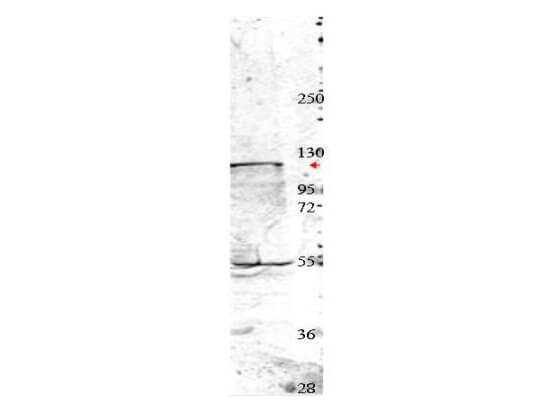Anti-NEDD4 (RABBIT) Antibody
NEDD4 Antibody
- SPECIFICATION
- CITATIONS
- PROTOCOLS
- BACKGROUND

| Host | Rabbit |
|---|---|
| Conjugate | Unconjugated |
| Target Species | Human |
| Reactivity | Human |
| Clonality | Polyclonal |
Application
| WB, E, I, LCI |
| Application Note | This affinity purified antibody has been tested for use in ELISA and western blotting using recombinant Nedd4 protein. Specific conditions for reactivity and detection of Nedd4 should be optimized by the end user. Expect a band approximately ~115 kDa in size corresponding to Nedd4 by western blotting in the appropriate cell lysate or extract. |
| Physical State | Liquid (sterile filtered) |
| Buffer | 0.02 M Potassium Phosphate, 0.15 M Sodium Chloride, pH 7.2 |
| Immunogen | This affinity purified antibody was prepared from whole rabbit serum produced by repeated immunizations with a peptide corresponding to an internal portion of the Nedd4 protein. |
| Preservative | 0.01% (w/v) Sodium Azide |
| Gene ID | 4734 |
|---|---|
| Other Names | 4734 |
| Purity | This product was affinity purified from monospecific antiserum by immunoaffinity chromatography. This antibody reacts with endogenous Nedd4 protein. A BLAST analysis was used to suggest reactivity with Nedd4 from human, horse and macaque based on a 100% homology with the immunizing sequence. Expect reactivity with Nedd4 from chimpanzee, rabbit, dog, and cattle based on a 94% homology with the immunizing sequence. Cross-reactivity with Nedd4 from other sources has not been determined. |
| Storage Condition | Store vial at -20° C prior to opening. Aliquot contents and freeze at -20° C or below for extended storage. Avoid cycles of freezing and thawing. Centrifuge product if not completely clear after standing at room temperature. This product is stable for several weeks at 4° C as an undiluted liquid. Dilute only prior to immediate use. |
| Precautions Note | This product is for research use only and is not intended for therapeutic or diagnostic applications. |
| Name | NEDD4 |
|---|---|
| Synonyms | KIAA0093, NEDD4-1, RPF1 {ECO:0000303|Pub |
| Function | E3 ubiquitin-protein ligase which accepts ubiquitin from an E2 ubiquitin-conjugating enzyme in the form of a thioester and then directly transfers the ubiquitin to targeted substrates. Specifically ubiquitinates 'Lys-63' in target proteins (PubMed:19920177, PubMed:21399620, PubMed:23644597). Involved in the pathway leading to the degradation of VEGFR-2/KDFR, independently of its ubiquitin-ligase activity. Monoubiquitinates IGF1R at multiple sites, thus leading to receptor internalization and degradation in lysosomes (By similarity). Ubiquitinates FGFR1, leading to receptor internalization and degradation in lysosomes (PubMed:21765395). Promotes ubiquitination of RAPGEF2 (PubMed:11598133). According to PubMed:18562292 the direct link between NEDD4 and PTEN regulation through polyubiquitination described in PubMed:17218260 is questionable. Involved in ubiquitination of ERBB4 intracellular domain E4ICD (By similarity). Part of a signaling complex composed of NEDD4, RAP2A and TNIK which regulates neuronal dendrite extension and arborization during development (By similarity). Ubiquitinates TNK2 and regulates EGF-induced degradation of EGFR and TNF2 (PubMed:20086093). Ubiquitinates BRAT1 and this ubiquitination is enhanced in the presence of NDFIP1 (PubMed:25631046). Ubiquitinates DAZAP2, leading to its proteasomal degradation (PubMed:11342538). Ubiquitinates POLR2A (PubMed:19920177). Functions as a platform to recruit USP13 to form an NEDD4-USP13 deubiquitination complex that plays a critical role in cleaving the 'Lys-48'-linked ubiquitin chains of VPS34 and then stabilizing VPS34, thus promoting the formation of autophagosomes (PubMed:32101753). |
| Cellular Location | Cytoplasm. Nucleus. Cell membrane {ECO:0000250|UniProtKB:P46935}; Peripheral membrane protein {ECO:0000250|UniProtKB:P46935}. Note=Predominantly cytoplasmic but also located in the nucleus (PubMed:11342538). Recruited to the plasma membrane by GRB10. Once complexed with GRB10 and IGF1R, follows IGF1R internalization, remaining associated with early endosomes. Uncouples from IGF1R-containing endosomes before the sorting of the receptor to the lysosomal compartment (By similarity). May be recruited to exosomes by NDFIP1 (PubMed:18819914). {ECO:0000250|UniProtKB:P46935, ECO:0000269|PubMed:11342538, ECO:0000269|PubMed:18819914} |

Thousands of laboratories across the world have published research that depended on the performance of antibodies from Abcepta to advance their research. Check out links to articles that cite our products in major peer-reviewed journals, organized by research category.
info@abcepta.com, and receive a free "I Love Antibodies" mug.
Provided below are standard protocols that you may find useful for product applications.
Background
NEDD4 (neural precursor expressed, developmentally down-regulated protein 4, aliases: KIAA0093, MGC176705, NEDD4-1) is a gene that is highly expressed in early embryonic central nervous system. A family of NEDD4-like proteins has more recently been defined. NEDD4 and NEDD4-like proteins contain multiple functional domains including a calcium-dependent phospholipid and membrane binding domain (C2 domain), two to four protein binding domains (WW domains), and an E3 ubiquitin-protein ligase domain (HECT domain). NEDD4 and NEDD4-2 have been shown to down-regulate both neuronal voltage-gated Na+ channels (NaVs) and epithelial Na+ channels (ENaCs) in response to increased intracellular Na+ concentrations. The WW domains of NEDD4 bind to PY motifs (amino acid sequence PPXY) found in multiple NaV and ENaC proteins, and ubiquitination of these proteins, mediated by the HECT domain of NEDD4, results in their internalization and removal from the plasma membrane. Mutation of the PY motifs in ENaC proteins is associated with Liddle's Syndrome, an autosomal-dominant form of hypertension. In addition to targeting sodium channels, NEDD4-2 has also been shown to negatively regulate TGF-β signaling by targeting Smad2 for degradation. Mouse and human NEDD4 are cleaved by caspase proteins during apoptosis, although the significance of this cleavage is not clear.
If you have used an Abcepta product and would like to share how it has performed, please click on the "Submit Review" button and provide the requested information. Our staff will examine and post your review and contact you if needed.
If you have any additional inquiries please email technical services at tech@abcepta.com.













 Foundational characteristics of cancer include proliferation, angiogenesis, migration, evasion of apoptosis, and cellular immortality. Find key markers for these cellular processes and antibodies to detect them.
Foundational characteristics of cancer include proliferation, angiogenesis, migration, evasion of apoptosis, and cellular immortality. Find key markers for these cellular processes and antibodies to detect them. The SUMOplot™ Analysis Program predicts and scores sumoylation sites in your protein. SUMOylation is a post-translational modification involved in various cellular processes, such as nuclear-cytosolic transport, transcriptional regulation, apoptosis, protein stability, response to stress, and progression through the cell cycle.
The SUMOplot™ Analysis Program predicts and scores sumoylation sites in your protein. SUMOylation is a post-translational modification involved in various cellular processes, such as nuclear-cytosolic transport, transcriptional regulation, apoptosis, protein stability, response to stress, and progression through the cell cycle. The Autophagy Receptor Motif Plotter predicts and scores autophagy receptor binding sites in your protein. Identifying proteins connected to this pathway is critical to understanding the role of autophagy in physiological as well as pathological processes such as development, differentiation, neurodegenerative diseases, stress, infection, and cancer.
The Autophagy Receptor Motif Plotter predicts and scores autophagy receptor binding sites in your protein. Identifying proteins connected to this pathway is critical to understanding the role of autophagy in physiological as well as pathological processes such as development, differentiation, neurodegenerative diseases, stress, infection, and cancer.


